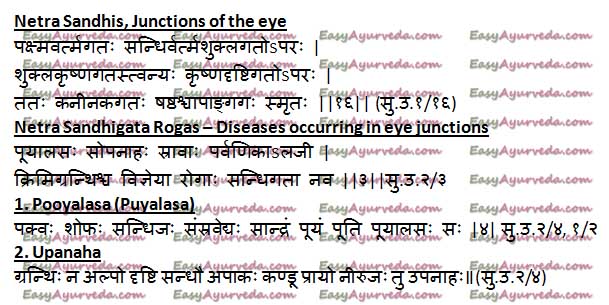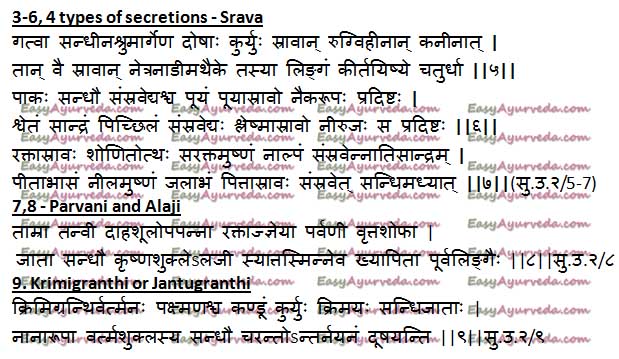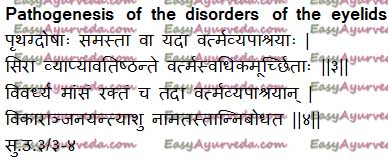Disorders Affecting Eye Junctions And Eyelids
Article by Dr Raghuram Y.S. MD (Ay) & Dr Manasa, B.A.M.S
Netra Sandhis are the junctions of various parts of the eyes.
Netra Sandhis or the junctions of the eye are 6 in number and occur between different parts of the eye.
Table of Contents
Parts of eyes
- Pakshma – means eyelashes
- Vartma – means eyelids or palpabrae
- Shukla Bhaga – Sclera or the white portion of the eye
- Krishna Bhaga – Iris or black portion of the eye
- Drishti – Aperture or slit of the iris
- Kaneenikaa – Meeting place of the two eyelids on the inner side (this itself is a sandhi, because it is a meeting place of two structures or parts)
- Apanga – Meeting place of the two eyelids on the outer side (this, like kaneenikaa is a sandhi because it is a meeting place of two structures or parts)
6 Netra Sandhis
The 6 Netra Sandhis are as enumerated below –
- Pakshma Vartma Gata Sandhi – This sandhi is the junction or meeting place of eyelashes and eyelids or palpabrae.
- Vartma Shukla Gata Sandhi – This sandhi is the junction or meeting place of eyelids and Sclera.
- Shukla Krushna Gata Sandhi – This sandhi is the junction or meeting place of Sclera and Iris. This can also be correlated with the Sclero-Corneal Junction or Limbus. But since Cornea is transparent, it is wise to take Iris as Krishna Bhaga.
- Krushna Drushti Gata Sandhi – This sandhi is the junction between the Iris and aperture / slit of the Iris. This Sandhi represents the margins of the Pupil. Pupil is a small opening at the centre of the Iris.
- Kaneenikaa Sandhi – This sandhi is the junction or meeting place of the upper and lower eyelids on the inner side of the eye, i.e. near the nose (inner canthus or inner angle of the eye).
- Apanga Sandhi – This sandhi is the junction or meeting place of the upper and lower eyelids on the outer side of the eye (outer canthus or the outer angle of the eye).
Related reading – Anatomy of the Eye, Ayurveda perspective

Netra Sandhigata Rogas
Netra Sandhigata Rogas – Diseases occurring in the junctions of the eye
Diseases occurring in the junctions of the eye are 9 in number. They are as mentioned below –
- Pooyalasa
- Upanaha
- Pooya sraava
- Shleshma sraava
- Rakta sraava
- Pitta sraava
- Parvanee
- Alajee
- Krimi granthi

Pooyalasa
Puyalasa is a swelling which occurs in the inner angle (inner canthus) of the eye or kaneenika sandhi (meeting place of upper and lower eyelids on the inner side of the eye). This swelling gradually undergoes suppuration followed by discharge of thick, viscous and foul smelling pus.
This condition can be compared to –
- Acute Dacryocystitis
- Chronic Dacryocystitis
- Lacrimal Abscess
Upanaha
Upanaha is a big cystic swelling occurring in the netra sandhi (junction of the eye), in the inner canthus of the eye to be precise. This swelling does not undergo suppuration. It is devoid of pain but is associated with itching.
Upanaha is correlated with Lacrimal Cyst.

Srava
The vitiated vata and other doshas (pitta, kapha) traveling through the ashru margas (lacrimal or tear ducts), on reaching the junctions of the eye (netra sandhi), kaneenika sandhi (inner canthus) to be precise, will cause discharges from the inner canthus without pain. Netra Srava is also called as Netra Nadis.
Netra Srava or discharges occurring from the junctions of the eye (inner canthus) are of 4 types. They are:
Puya Srava
Suppuration in the sandhi (inner canthus) will cause many types of puya srava or discharge of pus.
Shleshma Srava
White colored, thick, sticky and painless discharges from inner canthus is called shleshma srava.
Rakta Srava
The discharges occurring due to vitiated blood, occurring along with blood, excessive in quantity, hot in touch and dilute in nature is called rakta srava.
Pitta Srava
Yellowish blue watery discharges, hot on touch is called pitta srava.
Parvani and Alaji
Parvani – A thin, circular, copper colored (red colored) swelling occurring in the Krishna-shukla gata sandhi (sclera-corneal junction) is called Parvani. Parvani is caused by vitiated blood and is associated with burning sensation and pain.
Alaji – A similar swelling resembling Parvani which occurs in the Krishna-shukla gata sandhi which is thick and stout (in comparison to thin swelling in parvani) is called Alaji. It has the same symptoms as that of Parvani.
Parvani and Alaji can be correlated to –
- Marginal ulcers of Cornea (Keratitis Marginalis)
- Keratitis Marginalis Superficialis
- Keratitis Marginalis Profunda
- Diciform Keratitis
Krimigranthi or Janthugranthi
Small cysts caused by the many types of worms (parasites, microorganisms) in the vartma-pakshma gata sandhi (meeting place of eyelids and eye lashes) and vartma-shukla gata sandhi (meeting place of eyelids and sclera) are called Krimi Granthi or Jantu Granthi. This condition is associated with itching in the mentioned junctions. The worms eat up the mentioned junction areas and enter deep into the eye and also destroy the deeper structures (parts) of the eye.
Krimi Granthi can be compared to –
- Pediculi ciliaris
- Blepharitis
- Ulcerative Squamous
Netra Vartma
Netra Vartmagata Rogas – Disorders Affecting Eyelids
Netra Vartma is the names given to the eyelid. They are two in number, an upper eyelid and a lower eyelid. They are called urdhwa vartma and adho vartma in Ayurveda respectively.
Read – Classification of Eye Diseases As Per Ayurveda

Eyelids contribute to the Vartma Mandala
Mandala means circles. Vartma Mandala is the circle made up of eyelids. Both eyelids together roughly appear as a circle.
Read – Triphala Home Remedy For Eye Care
Eyelids contribute to two sandhis (joints of the eyes)
Pakshma Vartma Gata Sandhi
This is the meeting place of Pakshma (eyelashes) and Vartma (eyelids or palpabrae) of the eyes.
Vartma Shukla Gata Sandhi –
This is the meeting place of eyelids and Shukla bhaga (Sclera), the white of the eye.
Read – Netra Sandhigata Rogas – Disorders Affecting The Junctions Of The Eye
Eyelids form the Panchama and Shashta Patala (Fifth and Sixth Layers according to Ayuredic Anatomy)
Fifth and sixth Patala (layers of the eyes) constitute the Vartmaas (eyelids). They are called Vartma Patalas. Fifth layer form the upper eyelid. Sixth layer forms the lower eyelid.
Read – Anatomy of Eye: Netra Rachana: Ayurveda Perspective
Modern Correlation –
These two layers can be compared with the eyelids or Palpabrae of the eyes.
They form Kaninika and Apanga i.e. the inner and outer angles of the eye
Kaneenikaa (inner canthus) –
It is the inner angle of the eye. It is formed by the junction of both eyelids near the nose. Kaneenika is thus the sandhi (joint) present in the eyes, at the level of the nose and inner end of eyebrow. They are 2 in number and located in the medial side of eye on either side.
Apaanga (outer canthus) –
It is the outer angle of the eye. It is formed by junction of both eyelids towards the ear. It is thus the joint present in the eyes away from the nose, and near the outer end of the eyebrow. They are 2 in number and located in lateral side of eye on either side.
Read – Netra Tarpana Treatment For Eye Care Benefits, How To Do?
Vartmagata Rogas
Vartmagata Rogas – Diseases of the Eyelids
Pathogenesis of disorders of eyelids
Vitiated doshas, either singly or collectively get spread over and lodged in eyelids and the blood vessels of the eyelids. These doshas cause various kinds of disorders related to eyelids.
Skin, muscles, blood and fat tissues located in the eyelids get afflicted by the vitiated doshas and take part in the causation of diseases. Doshas increase the quantity of muscles and fat tissue located in the eyelids and cause protuberances. Totally 21 diseases are caused in the eyelids.
Read – Eye Diseases Causes, Pathogenesis, Symptoms, Treatment, Herbs

Name of disorders of eyelids with probable modern correlation
- Utsangini – Chalizion
- Kumbhika – Internal stye
- Pothaki – Trachoma / Granular lids
- Vartma sharkara – Granular form of lids
- Arsho vartma – papillary form
- Shushkarsha – chronic papillary forms
- Anjana Namika – External stye
- Vahala vartma / Bahala vartma – Multiple stye / chalazion
- Vartmavabandhaka – Non-inflammatory edema of the eyelids
- Klishta vartma – Angio-neurotic edema
- Vartma kardama – Non-ulcerative Blepharitis (read about Blepharitis inayurveda)
- Shyava vartma – Ulcerative Blepharitis
- Praklinna vartma – Blepharon
- Apariklinna vartma – Blepharophimosis
- Vatahata vartma – Paralysis of VII Cranial Nerve supplying Orbicularis Palpebrum muscle
- Arbuda – Tumors of the eyelids
- Nimisha – Affections of the III Cranial Nerve supplying Levator Palpabrae muscle
- Vartmarsha – Molluscum Contagiosum / Warts of eyelids
- Lagana – Meibomium cyst / Molluscum simplex
- Visa Vartma – Xanthalasma
- Pakshma Kopa – Trichiasis, Districhiasis, Entropion
Read – Ayurveda Eye Treatment Types, Methods – Ashtanga Hrudaya Sutrasthana 23
Dosha relation and prognosis
Dosha Relation in causation of disorders of eyelids and prognosis
Tridoshaja Sadhya
Below mentioned disorders are caused by simultaneous vitiation of all three doshas and are curable.
- Utsangini, Kumbhika
- Vartma Sharkara, Vahala vartma
- Vartma bandha, Vartma kardama, Aklinna vartma
- Shushkarsha, Arsho vartma, Shyava vartma
- Arbuda, Vartmarsha, Visa vartma
Read – Computer Vision Syndrome: Causes, Ayurvedic Remedies, Tips
Tridoshaja Yapya
Disorders caused by vitiated tridoshas but are manageable, not curable. Pakshmakopa
Raktaja sadhya
Disorders caused by vitiated blood and are curable.
- Anjananamika
- Klishta vartma
Read – Watery Eyes: Causes, Ayurvedic Treatment, Remedies
Kaphaja sadhya
Disorders caused by vitiated kapha and are curable.
- Lagana
- Pothaki
- Pariklinna vartma
Vataja Asadhya
Disorders caused by vitiated vata and are incurable.
- Vatahata Vartma
- Nimisha
- Click to Consult Dr Raghuram Y.S. MD (Ayu) – Email / Skype








